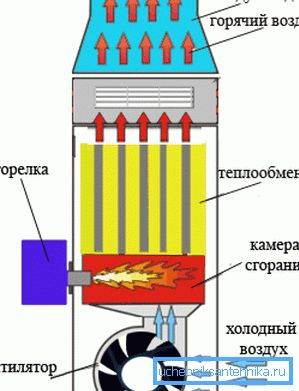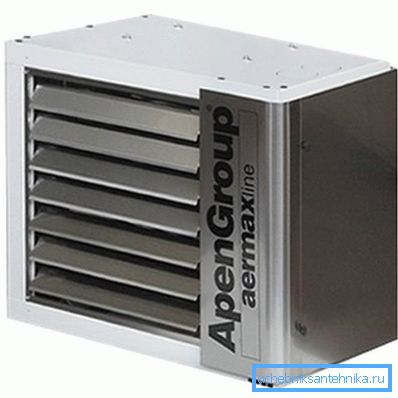Gas heat generators for air heating - features and types
Today, there are many different types of heaters, in particular, gas heat generators, which are used for air heating, have become widespread not so long ago.
In this article we will consider the device of these devices, their types and features.

General information
Recently, gas-air heating has become not only more and more popular, but is also considered the most promising. Moreover, it can be used for heating not only residential premises, but also production workshops.
The entire space is heated by means of a convection stream of hot air heated by a special device - a heat generator. The main feature of this system is that there is no intermediate link in it - the coolant, and this is due to high efficiency. Thus, air gas heating is a good way to quickly heat a large area of the room.

The advantages of heat generators
The great popularity of heating devices is associated with the following advantages:
- Gas is one of the most affordable fuels.
- Since the device heats the air, not the coolant, gas-air heating is the most economical and safe.
- Heating is carried out as quickly as possible. Usually one or two hours is enough to warm the house from top to bottom.
- All processes of these thermal devices are automated, which greatly simplifies control over the system and control of its operation modes.
- Universality - the device can be used not only for heating, but also for ventilation of rooms. In addition, many models allow you to change the burner for liquefied and natural gas.
- There is no need to carry out a large number of pipes and install radiators, due to which the price of the system is lower.

disadvantages
There are few disadvantages of these heating devices, however, they are available:
- As in the case of connecting any other gas equipment, before installing the heat generator, it is necessary to obtain permits.
- The need to arrange the chimney when installing stationary heat generators.
Other disadvantages of these devices do not have. The only thing you can add here is the need for the participation of specialists when debugging powerful equipment.

Device heat generator
The device of the heater is quite simple, since the apparatus consists of several nodes:
| Burner | Provides arson and subsequent combustion of fuel. |
| Air fan | Provides a continuous supply of oxygen to the burner, as well as the release of hot air from the air ducts |
| Heat exchanger | It is a stainless steel radiator. |
| Duct system | The channels through which the output of hot air to the outside. |
| The combustion chamber | Separation of the device in which the process of combustion of fuel. Its main purpose is to ensure complete combustion of the gas. |
The process of operation of this device is as follows:
- Cold air first enters the heater fan and from there into the heat exchanger.
- In the heat exchanger, the air is heated and under pressure enters the duct system.
- From the air ducts, hot air is ejected into the room, at the same time the fan forces new air masses into the heat exchanger.
Thus, the gas heatgenerator is a fairly simple, efficient and very reliable heating device. Moreover, the air circulating in the system does not cause corrosion or damage to its individual elements.
Note! You can install a gas heat generator yourself, but experts must connect it to the gas pipeline.

Types of heat generators
All existing generators of heating can be divided into two types:
- Mobile - devices can be both compact and have impressive enough dimensions. You can move the latter on trolleys specially mounted for them.
They are called “mobile” for the reason that they are not connected to the gas pipeline, but operate from gas cylinders, respectively, can be installed in any place. Most often, such devices are heated production plants. It should be noted that devices of this type especially need effective ventilation, since heated air is discharged with combustion products.

- Stationary - are connected to the gas pipeline.
These devices, in turn, are divided into two types:
- Suspended - designed, as a rule, for heating a single room. Such devices are most popular in country houses, as they do not occupy a useful place, they quickly heat up the room, and the instructions for installing them are extremely simple.
- Outdoor - are more cumbersome devices that are designed to heat large rooms or the whole house. Most models allow you to connect to them the duct system for uniform distribution of heat throughout the rooms of the house.

Of course, to provide effective gas air heating, you need to choose the right type of heater, but also its power. It is better to entrust the calculation of the heating system to specialists, or use special formulas that can be found on our portal.
Tip! In order for the gas oven of air heating to work as expected, it is necessary to ensure a constant flow of fresh air into the room. For this purpose, a ventilation system is used, which not only ensures the supply of oxygen, but also the discharge of carbon dioxide to the outside with excess combustion.
Here, perhaps, are all the main types and features of air-gas heat generators that you need to know if you decide to equip the heating system in the house in this way.
Conclusion
The use of gas generators in heating systems is an excellent highly efficient and economical solution. Moreover, due to the simplicity of operation, reliability and safety of this equipment, it can be used for heating in both residential and industrial premises.
From the video in this article, you can pick up some additional information on this topic.